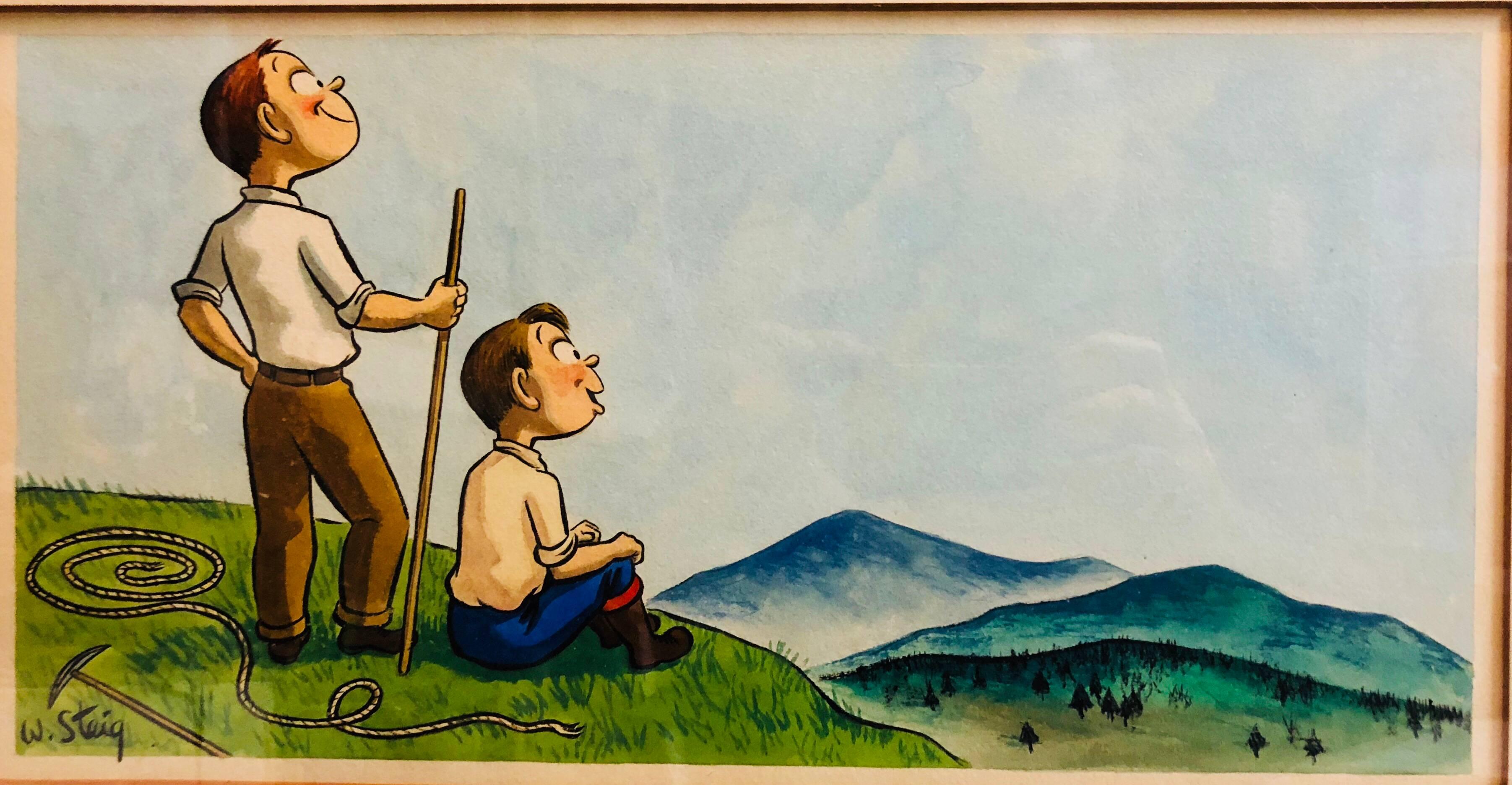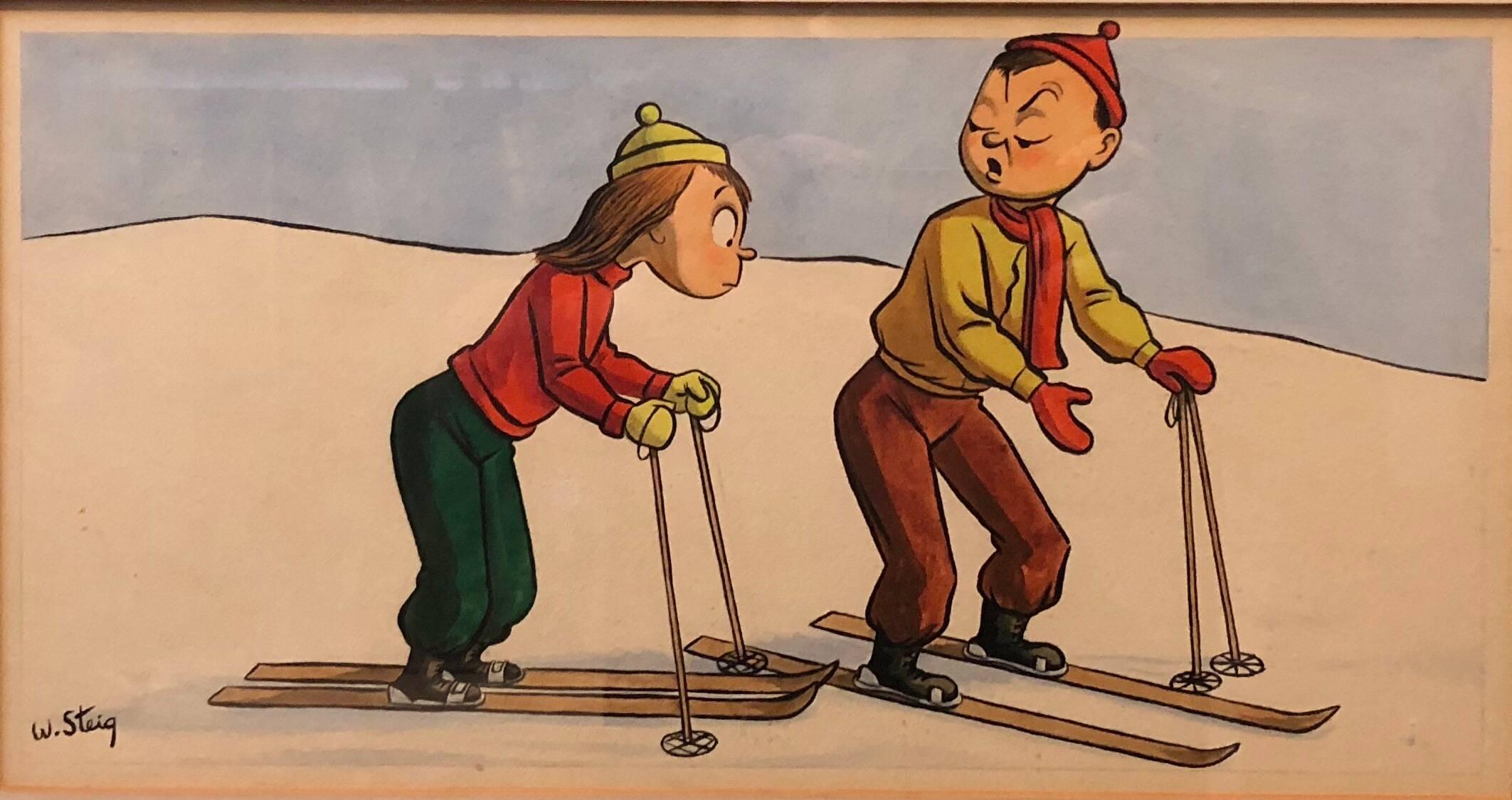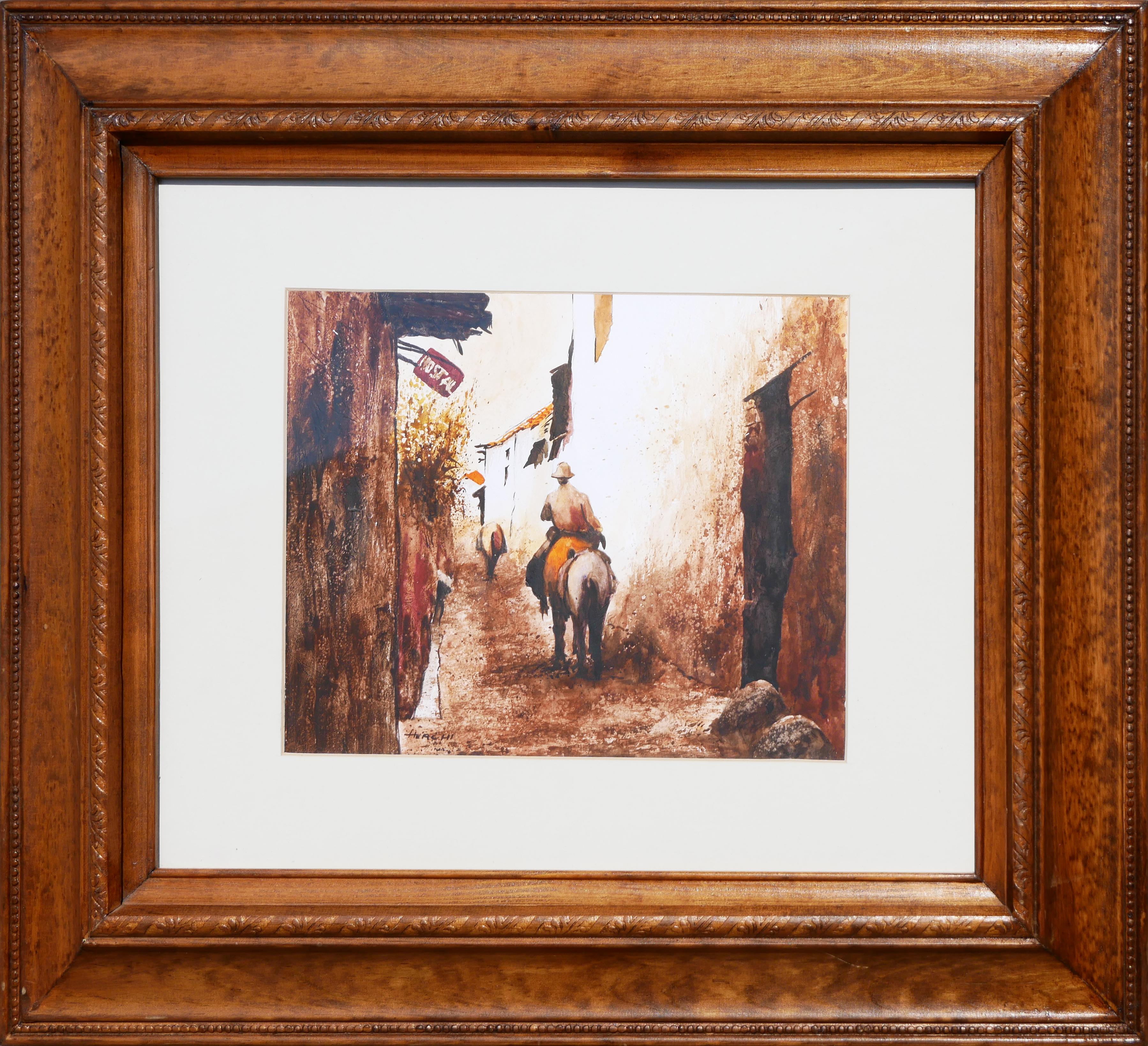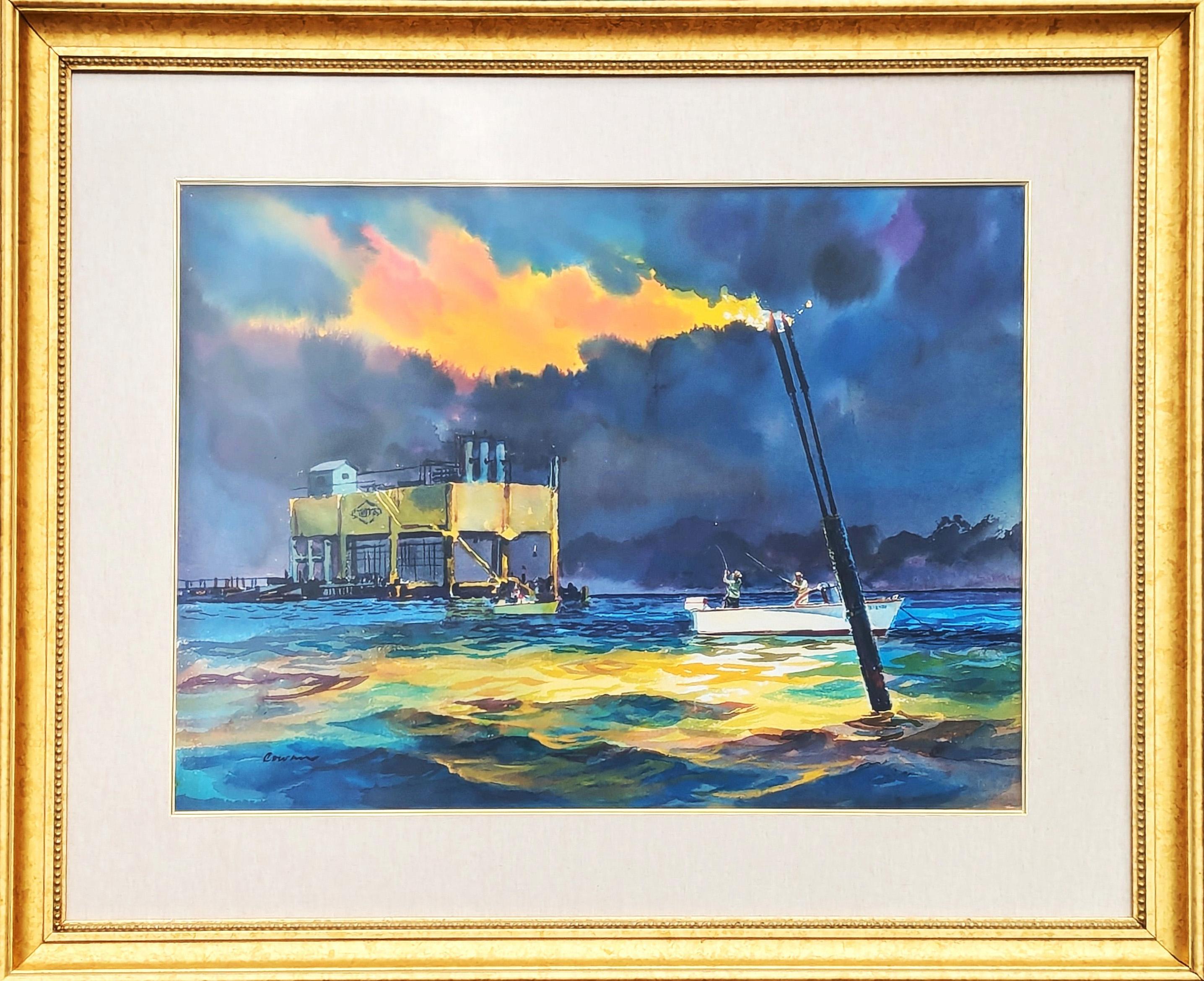Items Similar to Early Watercolor Painting of Redwood Forest in California
Want more images or videos?
Request additional images or videos from the seller
1 of 8
UnknownEarly Watercolor Painting of Redwood Forest in California20th Century
20th Century
About the Item
Watercolor painting of the Redwood forest located in California. Painting is mainly red and blue tones. The artist signed the painting in the bottom right corner. Work is framed in a wooden frame with a white matte.
Dimensions without Frame: H 10.5 in x W 6.75 in.
- Creation Year:20th Century
- Dimensions:Height: 17 in (43.18 cm)Width: 14 in (35.56 cm)Depth: 1 in (2.54 cm)
- Medium:
- Movement & Style:
- Period:
- Condition:
- Gallery Location:Houston, TX
- Reference Number:

About the Seller
5.0
Vetted Seller
These experienced sellers undergo a comprehensive evaluation by our team of in-house experts.
Established in 1969
1stDibs seller since 2014
782 sales on 1stDibs
Typical response time: 8 hours
- ShippingRetrieving quote...Ships From: Houston, TX
- Return PolicyA return for this item may be initiated within 7 days of delivery.
More From This SellerView All
- Brown-Toned Naturalistic Backstreet City Scene Watercolor LandscapeLocated in Houston, TXNeutral tone naturalistic city scene by an unknown artist. The work features a central figure on horseback riding down a village backstreet. The "hostal" street sign overhead indicat...Category
20th Century Naturalistic Figurative Drawings and Watercolors
MaterialsWatercolor
- "Trinity Flares" Modern Blue Toned Fishing Landscape Watercolor PaintingLocated in Houston, TXModern watercolor seascape painting by renowned sporting artists John P. Cowan. The work was originally created by Cowan to be used by Schlumberger as part of their fishing schedule calendar. Signed in the front lower left corner. Currently hung in a gold frame with a cream matting. Provenance includes a framed letter...Category
1960s Naturalistic Landscape Drawings and Watercolors
MaterialsWatercolor
- Niagra Falls Spring and Winter Watercolor LandscapesBy Maude LeachLocated in Houston, TXOriginal watercolor landscape painting of Niagra falls in the winter and in the spring. The pair of paintings are signed by the artist in the bottom corne...Category
20th Century Naturalistic Landscape Drawings and Watercolors
MaterialsWatercolor
- Naturalistic Watercolor European Harbor SceneLocated in Houston, TXNaturalistic European harbor scene with boats and figures preparing the boats of sailing. The work is signed and dated by the artist in the bottom corner. The paper comes with a blac...Category
1890s Naturalistic Landscape Drawings and Watercolors
MaterialsWatercolor
- Capriccio Landscape View with FiguresLocated in Houston, TXCapriccio painting in a greek or Italian style with women around a river. Capriccio is a fanciful architectural landscape painting. It was popular in Italy in the 18th Century. Most ...Category
Late 19th Century Baroque Landscape Drawings and Watercolors
MaterialsGouache
- "Jimmy and the Mower" Dark Humor Figurative Ink Comic DrawingLocated in Houston, TXDark humor figurative ink drawing of a male figure and a push mower signed "RM Shirley." The work features a young man holding his foot with his dismembered toe sitting near by next ...Category
20th Century Modern Figurative Drawings and Watercolors
MaterialsInk
You May Also Like
- Gustav Melcher ( German, 1898 -?) Boats off Venice Italy Ink Water Color c. 1918By Gustav MelcherLocated in Meinisberg, CHGustav Melcher (German, 1898-?) Segelschiffe vor Venedig - Sailing ships off Venice • India ink, water colour wash • Visible image ca. 11.5 x 18 cm • Glased Frame ca. 20 x 25 cm • Verso various inscriptions • Signed lower right Gustav Melcher was a German painter and a pioneer in film, film criticism and film theory and created this clever little picture of the skyline of Venice with various vessels. Going by the various inscriptions an the backing paper, this drawing was made in 1918 when Gustav was twenty years old and passed on three years later to Gertrud Melcher on the 1. 2. 1921. I have no reasons to doubt this information. The small drawing is still in its unopened frame, so maybe there is more information to be discovered , however this will be the privilege of the next owner. The picture also has retained its original antique frame – note that it has lost over the years various sections of the gesso decoration. The very precisely executed drawing is most enjoyable to look at and doing so, remember you are looking through the eyes of a young man, who saw this foreign sea cape over a century ago. Thank you for your interest and please note, that I offer free worldwide shipping on all my items. Gustav Melcher began his studies at the Düsseldorfer Kunstakademie under Peter Janssen and Eduard von Gebhardt. Originaly he was interested in figurative and portrait painting, but after time he decided to pursue the depiction of land- and marinescapes. Durin his studies the young artist undertook trips to visit England, Scotland, Belgium and France and he joined the artist society Malkasten. It was in those days he would hold speeches to his colleges about this new invention called ‘Kintopp’ – Melcher was a great advocate of the moving pictures...Category
1910s Naturalistic Landscape Drawings and Watercolors
MaterialsIndia Ink, Paper, Watercolor
- Whimsical Illustration Hiking Cartoon, 1938 Mt Tremblant Ski Lodge William SteigBy William Steig (b.1907)Located in Surfside, FLLighthearted Illustration of Outdoor Pursuits This one being cross country hiking signed "W. Steig" Provenance: from Mrs. Joseph B. Ryan, Commissioned by Joe Ryan for the bar at his ski resort, Mount Tremblant Lodge, in 1938. Mont Tremblant, P.Q., Canada Watercolor and ink on illustration board, sights sizes 8 1/2 x 16 1/2 in., framed. In 1938 Joe Ryan, described as a millionaire from Philadelphia, bushwhacked his way to the summit of Mont Tremblant and was inspired to create a world class ski resort at the site. In 1939 he opened the Mont Tremblant Lodge, which remains part of the Pedestrian Village today. This original illustration is on Whatman Illustration board. the board measures 14 X 22 inches. label from McClees Galleries, Philadelphia, on the frame backing paper. William Steig, 1907 – 2003 was an American cartoonist, sculptor, and, in his later life, an illustrator and writer of children's books. Best known for the picture books Sylvester and the Magic Pebble, Abel's Island, and Doctor De Soto, he was also the creator of Shrek!, which inspired the film series of the same name. He was the U.S. nominee for both of the biennial, international Hans Christian Andersen Awards, as a children's book illustrator in 1982 and a writer in 1988. Steig was born in Brooklyn, New York in 1907, and grew up in the Bronx. His parents were Polish-Jewish immigrants from Austria, both socialists. His father, Joseph Steig, was a house painter, and his mother, Laura Ebel Steig, was a seamstress who encouraged his artistic leanings. As a child, he dabbled in painting and was an avid reader of literature. Among other works, he was said to have been especially fascinated by Pinocchio.He graduated from Townsend Harris High School at 15 but never completed college, though he attended three, spending two years at City College of New York, three years at the National Academy of Design and a mere five days at the Yale School of Fine Arts before dropping out of each. Hailed as the "King of Cartoons" Steig began drawing illustrations and cartoons for The New Yorker in 1930, producing more than 2,600 drawings and 117 covers for the magazine. Steig, later, when he was 61, began writing children's books. In 1968, he wrote his first children's book. He excelled here as well, and his third book, Sylvester and the Magic Pebble (1969), won the Caldecott Medal. He went on to write more than 30 children's books, including the Doctor DeSoto series, and he continued to write into his nineties. Among his other well-known works, the picture book Shrek! (1990) formed the basis for the DreamWorks Animation film Shrek (2001). After the release of Shrek 2 in 2004, Steig became the first sole-creator of an animated movie franchise that went on to generate over $1 billion from theatrical and ancillary markets after only one sequel. Along with Maurice Sendak, Saul Steinberg, Ludwig Bemelmans and Laurent de Brunhofff his is one of those rare cartoonist whose works form part of our collective cultural heritage. In 1984, Steig's film adaptation of Doctor DeSoto directed by Michael Sporn was nominated for the Academy Award for Best Animated Short Film. As one of the most admired cartoonists of all time, Steig spent seven decades drawing for the New Yorker magazine. He touched generations of readers with his tongue–in–cheek pen–and–ink drawings, which often expressed states of mind like shame, embarrassment or anger. Later in life, Steig turned to children's books, working as both a writer and illustrator. Steig's children's books were also wildly popular because of the crazy, complicated language he used—words like lunatic, palsied, sequestration, and cleave. Kids love the sound of those words even if they do not quite understand the meaning. Steig's descriptions were also clever. He once described a beached whale as "breaded with sand." Throughout the course of his career, Steig compiled his cartoons and drawings into books. Some of them were published first in the New Yorker. Others were deemed too dark to be printed there. Most of these collections centered on the cold, dark psychoanalytical truth about relationships. They featured husbands and wives fighting and parents snapping at their kids. His first adult book, Man About Town, was published in 1932, followed by About People, published in 1939, which focused on social outsiders. Sick of Each Other, published in 2000, included a drawing depicting a wife holding her husband at gunpoint, saying, "Say you adore me." According to the Los Angeles Times, fellow New Yorker artist Edward Sorel...Category
1930s Naturalistic Figurative Drawings and Watercolors
MaterialsArchival Ink, Watercolor, Illustration Board
- Whimsical Illustration Skiing Cartoon, 1938 Mt Tremblant Ski Lodge William SteigBy William Steig (b.1907)Located in Surfside, FLLighthearted Illustration of Outdoor Pursuits This one being a Skiing scene, a boy and a girl on skis. signed W. Steig Provenance: from Mrs. Joseph B. Ryan, Commissioned by Joe Ryan for the bar at his ski resort, Mount Tremblant Lodge, in 1938. Mont Tremblant, P.Q., Canada Watercolor and ink on illustration board, sights sizes 8 1/2 x 16 1/2 in., framed. In 1938 Joe Ryan, described as a millionaire from Philadelphia, bushwhacked his way to the summit of Mont Tremblant and was inspired to create a world class ski resort at the site. In 1939 he opened the Mont Tremblant Lodge, which remains part of the Pedestrian Village today. This original illustration is on Whatman Illustration board. the board measures 14 X 22 inches. label from McClees Galleries, Philadelphia, on the frame backing paper. William Steig, 1907 – 2003 was an American cartoonist, sculptor, and, in his later life, an illustrator and writer of children's books. Best known for the picture books Sylvester and the Magic Pebble, Abel's Island, and Doctor De Soto, he was also the creator of Shrek!, which inspired the film series of the same name. He was the U.S. nominee for both of the biennial, international Hans Christian Andersen Awards, as a children's book illustrator in 1982 and a writer in 1988. Steig was born in Brooklyn, New York in 1907, and grew up in the Bronx. His parents were Polish-Jewish immigrants from Austria, both socialists. His father, Joseph Steig, was a house painter, and his mother, Laura Ebel Steig, was a seamstress who encouraged his artistic leanings. As a child, he dabbled in painting and was an avid reader of literature. Among other works, he was said to have been especially fascinated by Pinocchio.He graduated from Townsend Harris High School at 15 but never completed college, though he attended three, spending two years at City College of New York, three years at the National Academy of Design and a mere five days at the Yale School of Fine Arts before dropping out of each. Hailed as the "King of Cartoons" Steig began drawing illustrations and cartoons for The New Yorker in 1930, producing more than 2,600 drawings and 117 covers for the magazine. Steig, later, when he was 61, began writing children's books. In 1968, he wrote his first children's book. He excelled here as well, and his third book, Sylvester and the Magic Pebble (1969), won the Caldecott Medal. He went on to write more than 30 children's books, including the Doctor DeSoto series, and he continued to write into his nineties. Among his other well-known works, the picture book Shrek! (1990) formed the basis for the DreamWorks Animation film Shrek (2001). After the release of Shrek 2 in 2004, Steig became the first sole-creator of an animated movie franchise that went on to generate over $1 billion from theatrical and ancillary markets after only one sequel. Along with Maurice Sendak, Saul Steinberg, Ludwig Bemelmans and Laurent de Brunhofff his is one of those rare cartoonist whose works form part of our collective cultural heritage. In 1984, Steig's film adaptation of Doctor DeSoto directed by Michael Sporn was nominated for the Academy Award for Best Animated Short Film. As one of the most admired cartoonists of all time, Steig spent seven decades drawing for the New Yorker magazine. He touched generations of readers with his tongue–in–cheek pen–and–ink drawings, which often expressed states of mind like shame, embarrassment or anger. Later in life, Steig turned to children's books, working as both a writer and illustrator. Steig's children's books were also wildly popular because of the crazy, complicated language he used—words like lunatic, palsied, sequestration, and cleave. Kids love the sound of those words even if they do not quite understand the meaning. Steig's descriptions were also clever. He once described a beached whale as "breaded with sand." Throughout the course of his career, Steig compiled his cartoons and drawings into books. Some of them were published first in the New Yorker. Others were deemed too dark to be printed there. Most of these collections centered on the cold, dark psychoanalytical truth about relationships. They featured husbands and wives fighting and parents snapping at their kids. His first adult book, Man About Town, was published in 1932, followed by About People, published in 1939, which focused on social outsiders. Sick of Each Other, published in 2000, included a drawing depicting a wife holding her husband at gunpoint, saying, "Say you adore me." According to the Los Angeles Times, fellow New Yorker artist Edward Sorel...Category
1930s Naturalistic Figurative Drawings and Watercolors
MaterialsArchival Ink, Watercolor, Illustration Board
- Trees - Original Watercolor - 1950sBy André Roland BrudieuxLocated in Roma, ITTrees is an original watercolor drawing, realized by André Roland Brudieux in 1950s. The state of preservation of the artwork is very good and aged. Sheet dimension: 37.5 x 32.5 cm....Category
1950s Naturalistic Figurative Drawings and Watercolors
MaterialsWatercolor
- Norwegian Pine Grove - The inner glow of the trees -Located in Berlin, DEThemistokles von Eckenbrecher (1842 Athens - 1921 Goslar), Norwegian pine grove, 1901. Watercolor on blue-green paper, 30 x 22 cm. Signed, dated and inscribed in his own hand "TvE. Fagermes [i.e. Fagermes]. 26.6.[19]01." - Slight crease throughout at left margin, otherwise in good condition. About the artwork Themistokles von Eckenbrecher often traveled to Norway to study the nature that fascinated him there. On June 26, 1901, near the southern Norwegian town of Fagernes, in the summer evening sun, he saw a small pine grove, which he immediately captured in a watercolor. He exposed the trees growing on a small hill in front of the background, so that the pines completely define the picture and combine to form a tense motif. The tension comes from the contrast of form and color. The trunks, growing upward, form a vertical structure that is horizontally penetrated by the spreading branches and the pine needles, which are rendered as a plane. This structural tension is further intensified by the color contrast between the brown-reddish iridescent trunks and branches and the green-toned needlework. Themistokles von Eckenbrecher, however, does not use the observed natural scene as an inspiring model for a dance of color and form that detaches itself from the motif and thus treads the path of abstracting modernism. Its inner vitality is to be brought to light and made aesthetically accessible through the work of art. It is precisely in order to depict the inner vitality of nature that von Eckenbrecher chooses the technique of watercolor, in which the individual details, such as the needles, are not meticulously worked out, but rather a flowing movement is created that unites the contrasts. The trees seem to have formed the twisted trunks out of their own inner strength as they grew, creatingthose tense lineations that the artist has put into the picture. The inner strength continues in the branches and twigs, culminating in the upward growth of the needles. At the same time, the trunks, illuminated by the setting sun, seem to glow from within, adding an almost dramatic dimension to the growing movement. Through the artwork, nature itself is revealed as art. In order to make nature visible as art in the work, von Eckenbrecher exposes the group of trees so that they are bounded from the outside by an all-encompassing contour line and merge into an areal unity that enters into a figure-ground relationship with the blue-greenish watercolor paper. The figure-ground relationship emphasizes the ornamental quality of the natural work of art, which further enforces the artwork character of the group of trees. With the presentation of Themistokles von Eckenbrecher's artistic idea and its realization, it has become clear that the present watercolor is not a study of nature in the sense of a visual note by the artist, which might then be integrated into a larger work context, but a completely independent work of art. This is why von Eckenbrecher signed the watercolor. In addition, it is marked with a place and a date, which confirms that this work of nature presented itself to him in exactly this way at this place at this time. At the same time, the date and place make it clear that the natural work of art has been transferred into the sphere of art and thus removed from the time of the place of nature. About the artist Themistocles' parents instilled a life of travel in their son, who is said to have spoken eleven languages. His father, who was interested in ancient and oriental culture, was a doctor and had married Francesca Magdalena Danelon, an Italian, daughter of the British consul in Trieste. During a stay in Athens - Gustav von Eckenbrecher was a friend of Heinrich von Schliemann and is said to have given him crucial clues as to the location of Troy - Themistokles saw the light of day in 1842. After an interlude in Berlin, where Themistokles was educated at the English-American School, the journey began again. From 1850 to 1857 the family lived in Constantinople, after which the father opened a practice in Potsdam, where Themistokles, who wanted to become a painter, was taught by the court painter Carl Gustav Wegener. In 1861 the von Eckenbrechers left Potsdam and settled in Düsseldorf. There Themistokles received two years of private tuition from Oswald Aschenbach, who greatly admired the talented young artist. After his artistic training, he undertook extensive travels, often accompanied by Prince Peter zu Sayn-Wittgenstein, which took him to northern and eastern Europe, but above all to the Middle East and even to South America. The paintings that resulted from these journeys established his artistic reputation and led to his participation in large panoramas such as the 118 x 15 metre Entry of the Mecca Caravan into Cairo, painted for the City of Hamburg in 1882. 1882 was also the start of a total of 21 study trips to Scandinavia, most of them to Norway, and the unique Norwegian landscape with its rugged fjords became a central motif in his work. Along with Anders Askevold and Adelsteen Normann...Category
Early 1900s Naturalistic Landscape Drawings and Watercolors
MaterialsWatercolor
- Charles George Nicholls - Watercolour 1805 - Palace on the Ganges, Anglo - IndiaBy Charles George NichollsLocated in Meinisberg, CHCharles George Nicholls (English, flourished 1792 - 1818) Picturesque Gangetic Landscape in India • Circa 1805 • Watercolour on thick paper, ca. 20 x 49.5 cm • Mounted behind a modern passpartout, visible image ca. 19 x 49 cm • Original Georgian frame (newly glassed) , ca. 39 x 70 cm • Signed lower left corner Worldwide shipping is complimentary - There are no additional charges for handling & delivery. Very detailed watercolor painting - note how light reflecting off the water surface was skillfully created by scratching the paper surface. Charles G(J)eorge Nicholls, originally a merchant seaman, was a contemporary of Thomas and William Daniell, and like them, he made several sketching trips whilst in India, including up the Dohab, which is from where this drawing appears to be of. He worked as draughtsman for the East India Company based in Calcutta and was also employed by the Office of the Surveyor-General, where he was involved in the Survey of Orissa, South Bengal. Unfortunately bad eyesight truncated his career and he returned to England in 1815. Nicholls signed his middle name’George’ using a ‘G’, aswell as a ‘J.’ Nicholl’s work surfaces from time to time and can command high prices at auction – especially for his Indian landscapes. For example, a drawing by Nicholls ( a page of an album) was auctioned by Sotheby's (Valuable Printed Books, June 1997, Lot 407), or a series of water coulours were auctioned by Christie's (Visions of India, June 1998) and in September 2000 two small drawings were auctioned again by Christie's (Exploration & Travel with Visions of India). Also, I know there is a unsigned water colour titled 'Bridge over the River Bama by Benares' in the collection of the Oriental & India Office Collections (OICO) at the British Library. Here is a rare opportunity, to acquire a large format watercolor (double album page), featuring a very impressive view of what India looked like over 200 years ago - seen through the eyes of a skilled artist, in employment by the famous East India Company. I also think that as India opens up more and more rapidly to the world and enjoys increasing prosperity, the interest in cultural heritage, trophy objects like the one I am offering here today, will find their way back to India, into a collection or onto a wall in a chic office or luxurious apartment. The water colour drawing...Category
Early 1800s Naturalistic Landscape Drawings and Watercolors
MaterialsWatercolor, Paper
Recently Viewed
View AllMore Ways To Browse
California Paintingers
California Painting
Early California
Early California Art
Early California Artists
Early California Paintings
Early 20th Century California Artists
California Landscape Watercolor
California Landscape Watercolor Paintings
Vintage Forest Sign
Early California Watercolor
Redwood Used
Redwood Vintage
Redwood Art
California Redwood
Redwood Painting
Redwood Frame
Redwood Landscape





